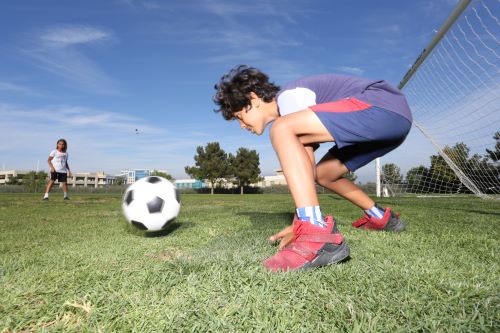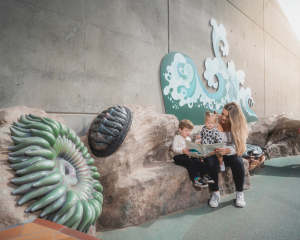
After-school sports and activities are changing, but kids can still reap their many benefits.
In a typical week, an Orange County family can spend a significant amount of time participating in after-school sports — going to soccer practice, attending a basketball game, Little League tryouts or some other athletic endeavor.
Experts say after-school sports and activities can play an important role in child development.
“Sports and extracurricular activities can be monumental in several areas of a child’s development,” said Child Life Specialist Adrienne Feilden, of Fountain Valley Regional Hospital & Medical Center. “Not only do such activities offer play, which focuses on gross motor, fine motor and hand-eye coordination skills, they can also help to further develop social and emotional skills. Learning to work and problem-solve as a group are much needed socialization skills.”
We are living in atypical times, and the usual after-school sports and activities may not be an option right now. But there are still ways children can reap some of the same benefits.
“Directors of extracurricular activities have now had time to adjust their practices to be able to provide safe ways of providing youth with options for many after-school activities, and sports have transitioned their modes of operating to be able to accommodate social distancing guidelines,” said Jessie Borelli, associate professor in the Department of Psychological Science at University of California, Irvine. “Activities that can be done completely outdoors and where children can socially distance without sacrificing core aspects of the activity are the most well-suited to transition to the current circumstance. Tennis clinics are great options because tennis typically involves distance between players. Youth soccer practice can be modified so that it now involves drills that maintain a minimum of six feet between players. Theater groups have transitioned to conducting rehearsals and even performances via Zoom.”
Dorain Cassell, executive director of Child and Youth Development for YMCA of Orange County, said that after-school activities and sports will have to be determined by the area and locality of each family and exactly what the family’s needs are. Cassell said if families are looking for more specific programming, such as a soccer camp or clinic, they will need to research and find a program and location that aligns with their overall goals.
“Everything we do at the YMCA is through the lens of safety with the current pandemic,” said Cassell. “Our after-school activities at the YMCA will keep their same focus but with added precautions. … Our clubs will vary based on location as we have YMCA sites throughout Orange County. We will also have outdoor time where children will be able to participate in physical activity in a safe manner. Another area our sites and staff are focusing on is assisting in scaffolding the current social guidelines, as we all adjust to our new normal. It is important for children to get social interaction for their own development in a safe environment.”

Cassell said the YMCA of Orange County works closely with the local health department, and adheres to all CDC, state and local guidelines.
“For parents, research is key. As many new options are beginning to open back up, so what was unavailable two weeks ago may be an option now,” Cassell said. “Ultimately, parents will decide on what is most valuable at this time for their children. This is a great opportunity to communicate these changes in a way that reinforces the values of flexibility, perseverance and accountability with our children. What we are beginning to see happen now are communities, businesses and individuals responding to the most recent order from the governor and coming together to find creative ways to remain safe while also maintaining their livelihoods.”
Robert Santana, CEO of the Boys & Girls Clubs of Central Orange Coast, which covers Costa Mesa, Irvine, Newport Beach, Orange and Santa Ana, said that most after-school activities and sports organizations are modifying protocols to implement new safety measures that have been recommended by the CDC as a result of the COVID-19 pandemic.
“While our expertise and mission at Boys & Girls Clubs of Central Orange Coast are focused in particular areas, our priority is always safety,” said Santana. “These new safety measures will most certainly change the way programs are delivered and can limit capacity. This ultimately means there may be limited spots available and parents should plan to enroll their children in programs they are interested in before they fill up.”
Feilden said it’s a good time for families to get creative.
“Utilizing platforms such as Zoom can be helpful in fortifying teamwork and team planning/socialization,” she said. “Including children in the challenge to modify activities related to safety needs can also be a way to engage them cognitively and to help them understand the reasons for measures such as social distancing and hand-sanitizing, etc. Parents can also help his/her child to develop practice routines at home and engage the child in deciphering when and how often these should occur.”
She said parents can also include their children in researching activities that incorporate the skills of his or her favorite sports in order to keep the activities changing and fun.
“Other options include enrolling the child in one-on-one coaching for the specific activity or sport during this pandemic time,” she said. “This limits the amount of people the child is exposed to while continuing to work on skills and receive and incorporate feedback. This can also be a great time for a child to ‘try on’ another sport or activity that is less team-focused, such as golf, music or dance.”
Dr. Chris Koutures, a sports physician at ActiveKidMD Pediatrics and Sports Medicine in Anaheim Hills, said the American Academy of Pediatrics promotes regular physical activity to foster psychological well-being, increase self-esteem and capacity for learning. He said it can also help children and adolescents handle stress better — particularly important in our current environment, he added.
“For some kids, the after-school sport or activity is the main or only reason why they want to go to school or have connection with their peers and adults outside of their homes,” he said.

He said academics and athletics can work hand-in-hand.
“It may not be fair to compare relative importance of academics versus after-school sports and activities, but rather better to say that they work in tandem,” he said. “Appropriate levels of physical activity can have a positive effect on academic work. Good exercise can make for good academics. Experience does show that acute bouts of physical activity and regular amounts of moderate to vigorous physical activity improve thinking skills, including memory, processing speed, attention and academic performance. Many kids will only exercise if they have formal or organized after-school sports and activities — either by choice or lack of other opportunities.”
Borelli said that while each individual activity offers its own unique opportunities for promoting children’s healthy development — karate and dance may help children develop discipline while art helps children develop creativity, for example — they also share things in common.
“These after-school activities provide important opportunities for children to develop skills and a sense of competence in a non-academic sphere and to socialize with peers in a lower-pressure context, one in which the rules are more flexible or different,” she said. “Children also have the opportunity to socialize across grade lines, which can provide more flexibility for children who get along better with kids who are slightly older or younger than they are. In some activities, silliness is encouraged or even promoted, which enables children to relate to one another in different ways, developing their freedom of expression and confidence.”
She said parents can help children learn about how to engage in social distancing before they begin their involvement in any activity.
“Explaining the rationale behind social distancing and modeling appropriate social distancing behavior can be helpful tools for growing children’s capacity to use social distancing behavior,” she said. “Children pick up on the signals they receive from adults regarding these behaviors, so if adults send the message to children that social distancing and mask wearing are important, children will follow suit and treat these behaviors seriously. Further, if children understand that engaging in these behaviors is a precondition to being able to partake in their cherished activities, they may be even more motivated to adhere to them.”
Tim Hornig, Capistrano Unified School District’s executive director of secondary education, said after-school sports and activities are extremely important for children’s physical, emotional and social development.
“These activities offer our student athletes opportunities to maintain a healthy balance,” he said. “Our teams offer students numerous relationships with the sporting community as well as all of their peers and are often the motivation students have for attending our amazing schools.”
He said children can still benefit from activities without an organized league. (As of printing, he said the California Interscholastic Federation had amended traditional high school seasons of sport, condensing all sports into two seasons — winter and spring for the 2020-2021 school year. And CUSD’s sports teams are now able to return to conditioning activities in accordance with county and state health and safety guidelines.)
“Not all sports need to be in an organized league or practice,” he said. “Oftentimes, just getting out and shooting baskets, running or shooting goals with your student can offer a chance to ‘train’ while also enjoying the simplicity of the game. Oftentimes, all of our drive is around results and competition, but there is a great benefit of getting back to the root of these kids playing when they were 6 — because it was fun.”
By Jessica Peralta







Leave a Reply